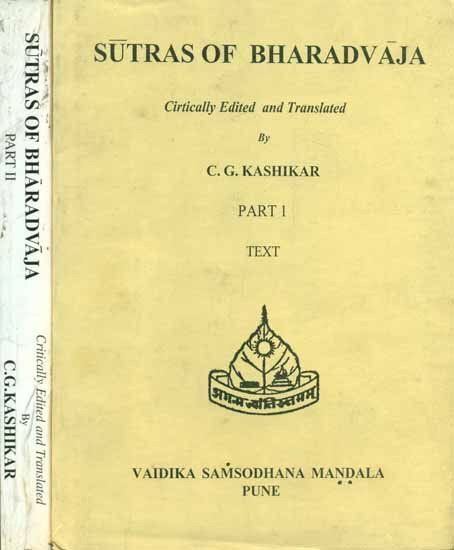Bharadvaja-srauta-sutra
by C. G. Kashikar | 1964 | 166,530 words
The English translation of the Bharadvaja-Srauta-Sutra, representing some of the oldest texts on Hindu rituals and rites of passages, dating to at least the 1st millennium BCE. The term Srautasutra refers to a class of Sanskrit Sutra literature dealing with ceremonies based on the Brahmana divisions of the Veda (Sruti). They include Vedic rituals r...
Praśna 4, Kaṇḍikā 11
1. (He should recite over) the spoon (being placed within the altar)[1] the verses, “Do thou, pleasant to me, be seated on the earth. May I be extended with offspring and cattle in the heavens. Do thou be seated in the heaven, on the earth and in the mid-region. May I become superior, may my enemies be downtrodden.[2]—This spoon, flowing in a hundred currents, tends to offer oblations with the Anuṣṭubh metre. It besmears all divisions of the sacrifice with the divine protection belonging to Bṛhaspati.”[3]
2. Over the vessel of the clarified butter (being placed within the altar) the verse, “This vessel, full of clarified butter, is a spring having uninterrupted stream and a hundred currents, with the divine protection belonging to Maruts.”[4]
3. He should recite over the two cakes being besmeared,[5] the formulas, “Thou art the satiety, the Gāyatrī metre; do thou satiate me with lustre and Brahman-splendour. Thou art satiety, the Triṣṭubh metre; do thou satiate me with vigour and valour. Thou art satiety, the Jagatī metre; do thou satitate me with offspring and cattle.”
4. He should touch the oblations which have been placed within the altar: The cake intended for Agni[6] with the formula, “Thou art the sacrifice resting all round; may the past and the future rest with me; may there be a hundred benedictions for me; may there be a thousand jubilations full of food and cattle.”[7] The cake intended for Agni-Soma[6] with the formula, “Thou art Prajāpati resting all round; may the past and the future rest with me; may there be a hundred benedictions...”[7] The cake intended for Indra-Agni[6] with the verse, “Who desires less in this sacrifice for us and for me the sacrificer, may Indra-Agni drive him away from this region. May I obtain valorous progeny.”[8]
Footnotes and references:
[1]:
II.9.16.
[2]:
Taittirīya-brāhmaṇa III.7.6.10,11.
[3]:
Taittirīya-brāhmaṇa III.7.6.8,9.
[4]:
Taittirīya-brāhmaṇa III.7.6.11.
[5]:
II.11.2.
[6]:
II.11.8.
[7]:
Taittirīya-brāhmaṇa III.7.6.11,12.
[8]:
Taittirīya-brāhmaṇa III.7.6.14.
